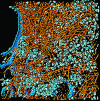Life in a crowded world
- PMID: 14710181
- PMCID: PMC1298967
- DOI: 10.1038/sj.embor.7400056
Life in a crowded world
Abstract
Workshop on the Biological Implications of Macromolecular Crowding
Figures








Similar articles
-
Effects of macromolecular crowding on protein folding and aggregation studied by density functional theory: dynamics.Phys Rev E Stat Nonlin Soft Matter Phys. 2002 Nov;66(5 Pt 1):051902. doi: 10.1103/PhysRevE.66.051902. Epub 2002 Nov 7. Phys Rev E Stat Nonlin Soft Matter Phys. 2002. PMID: 12513518
-
Compartmentation of protein folding in vivo: sequestration of non-native polypeptide by the chaperonin-GimC system.EMBO J. 1999 Jan 4;18(1):75-84. doi: 10.1093/emboj/18.1.75. EMBO J. 1999. PMID: 9878052 Free PMC article.
-
Protein aggregation in crowded environments.Biol Chem. 2006 May;387(5):485-97. doi: 10.1515/BC.2006.064. Biol Chem. 2006. PMID: 16740119 Review.
-
Macromolecular crowding perturbs protein refolding kinetics: implications for folding inside the cell.EMBO J. 2000 Aug 1;19(15):3870-5. doi: 10.1093/emboj/19.15.3870. EMBO J. 2000. PMID: 10921869 Free PMC article.
-
Beyond the excluded volume effects: mechanistic complexity of the crowded milieu.Molecules. 2015 Jan 14;20(1):1377-409. doi: 10.3390/molecules20011377. Molecules. 2015. PMID: 25594347 Free PMC article. Review.
Cited by
-
Pre-Molten, Wet, and Dry Molten Globules en Route to the Functional State of Proteins.Int J Mol Sci. 2023 Jan 26;24(3):2424. doi: 10.3390/ijms24032424. Int J Mol Sci. 2023. PMID: 36768742 Free PMC article. Review.
-
J-aggregation of 5, 10, 15, 20-tetraphenyl-21H, 23H-porphinetetrasulfonic acid in a molecular crowding environment simulated using dextran.Anal Sci. 2022 Dec;38(12):1505-1512. doi: 10.1007/s44211-022-00185-5. Epub 2022 Sep 1. Anal Sci. 2022. PMID: 36050568
-
Direct observation of protein unfolded state compaction in the presence of macromolecular crowding.Biophys J. 2013 Feb 5;104(3):694-704. doi: 10.1016/j.bpj.2012.12.020. Biophys J. 2013. PMID: 23442920 Free PMC article.
-
Crowding induces complex ergodic diffusion and dynamic elongation of large DNA molecules.Biophys J. 2015 Mar 10;108(5):1220-8. doi: 10.1016/j.bpj.2015.02.002. Biophys J. 2015. PMID: 25762333 Free PMC article.
-
Molecular crowding enhances native structure and stability of alpha/beta protein flavodoxin.Proc Natl Acad Sci U S A. 2007 Nov 27;104(48):18976-81. doi: 10.1073/pnas.0705127104. Epub 2007 Nov 16. Proc Natl Acad Sci U S A. 2007. PMID: 18024596 Free PMC article.
References
-
- Baumeister W (2002) Electron tomography: towards visualizing the molecular organization of the cytoplasm. Curr Opin Struct Biol 12: 679–684 - PubMed
-
- Bray D (1998) Signalling complexes: biophysical constraints on intercellular communication. Annu Rev Biophys Biomol Struct 27: 59–75 - PubMed
-
- Brown MP, Royer C (1997) Fluorescence spectroscopy as a tool to investigate protein interactions. Curr Opin Biotech 8: 45–49 - PubMed
Publication types
MeSH terms
Substances
LinkOut - more resources
Full Text Sources
Other Literature Sources

